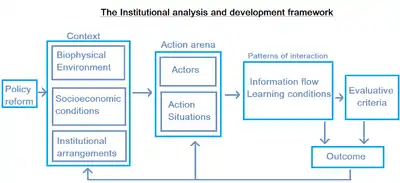The Institutional Analysis and Development framework (IAD) was developed by Elinor Ostrom, an American political scientist, who was the first woman to receive the Nobel Memorial Prize in Economic Sciences in 2009.[1] The IAD relates a set of concepts to help in the analysis of commons, such as fishery stocks, woodlands. Ostrom explored which institutional structures support arrangements that handle those resource stocks in a sustainable way, balancing individuals' use with the interest of a wider public. Under the rational choice models, the IAD was devised in an attempt to explain and predict outcomes by formally exploring and documenting the governance structures, the actors' positions, and the informal and formal rules devised for individuals to extract resources from the commons resource. Thus, the IAD is a systematic method to document policy analysis functions similar to analytic technique commonly used in physical and social sciences and understand how institutions operate and change over a period of time.[2][3]
Components of the framework

Ostrom thought of the IAD as a "multi-level conceptual map" with which one could zoom in and out of particular hierarchical parts of the governance structures in a social system.
The IAD framework helps to perceive complex collective action problems by dividing them into 'action arenas', that are smaller pieces of practically understandable function.[2] The analyst assumes that the structure of the action situation is fixed in the short-term. For an action situation to exist, there must be "actors in positions" (the number of possible roles that are available in this recurring interaction situation).[4] Actors have choices within the existing (rule) structure. In the study of outcomes from collective choice situations, actors are influenced by the institutional arrangements, the socio-economic conditions, and the physical environment.[5] The institutional arrangements can be studied by seven rule types (as per below).[4]
| Rules | Description |
|---|---|
| Position | The number of possible "positions" actors in the action situation can assume (in terms of formal positions these might be better described as job roles, while for informal positions these might rather be social roles of some capacity |
| Boundary | Characteristics participants must have in order to be able to access a particular position |
| Choice | The action capacity ascribed to a particular position |
| Aggregation | Any rules relating to how interactions between participants within the action situation accumulate to final outcomes (voting schemes etc.) |
| Information | The types and kinds of information and information channels available to participants in their respective positions |
| Pay-off | The likely rewards or punishments for participating in the action situation |
| Scope | Any criteria or requirements that exist for the final outcomes from the action situation |
References
- ↑ Ostrom, Elinor. (1990) Governing the Commons: The Evolution of Institutions for Collective Action. New York: Cambridge University.
- 1 2 Michael D. McGinnis. "An Introduction to IAD and the Language of the Ostrom Workshop: A Simple Guide to a Complex Framework for the Analysis of Institutions and Their Development". Indiana University. Retrieved 2 February 2015.
- ↑ Margaret M. Polski; Elinor Ostrom. An Institutional Framework for Policy Analysis and Design (PDF). Retrieved 1 February 2015.
- 1 2 3 Elinor Ostrom (2009). Understanding Institutional Diversity (PDF). Princeton: Princeton University Press. ISBN 9781400831739. Retrieved 30 January 2015.
- ↑ Krister Andersson. "Understanding decentralized forest governance: an application of the institutional analysis and development framework". Sustainability: Science, Practice, & Policy. Archived from the original on 5 September 2015. Retrieved 2 February 2015.
Further reading
- Elinor Ostrom. "Institutional Analysis and Development: Elements of the Framework in Historical Perspective" (PDF). Retrieved 2 February 2015.
- Historical Developments and Theoretical Approaches in Sociology. Ramsey: Eolss Publishers. 2010. ISBN 9781848263321.